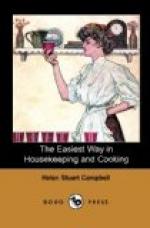Mountain sheep and cattle have the finest-flavored meat, and are also richest in nitrogenous matter. The mountain mutton of Virginia and North Carolina is as famous as the English Southdown; but proper feeding anywhere will make a new thing of the ordinary beef and mutton. When our cattle are treated with decent humanity,—not driven days with scant food and water, and then packed into cars with no food and no water, and driven at last to slaughter feverish and gasping in anguish that we have no right to permit for one moment,—we may expect tender, wholesome, well-flavored meat. It is astonishing that under present conditions it can be as good as it is.
In well-fed animals, the fat forms about a third of the weight, the largest part being in the loin. In mutton, one-half is fat; in pork, three-quarters; while poultry and game have very little.
The amount of bone varies very greatly. The loin and upper part of the leg have least; nearly half the entire weight being in the shin, and a tenth in the carcass. In the best mutton and pork, the bones are smaller, and fat much greater in proportion to size.
VEAL and LAMB, like all young meats, are much less digestible than beef or mutton. Both should have very white, clear fat; and if that about the kidneys is red or discolored, the meat should be rejected. Veal has but sixteen parts of nitrogenous matter to sixty-three of water, and the bones contain much more gelatine than is found in older animals. But in all bones much useful carbon and nitrogen is found; three pounds of bone yielding as much carbon, and six pounds as much nitrogen, as one pound of meat. Carefully boiled, this nutriment can all be extracted, and flavored with vegetables, form the basis of an endless variety of soups.
PORK is of all meats the most difficult to digest, containing as it does so large a proportion of fat. In a hundred parts of the meat, only nine of nitrogen are found, fat being forty-eight and water thirty-nine, with but two of salty matters. Bacon properly cured is much more digestible than pork, the smoke giving it certain qualities not existing in uncured pork. No food has yet been found which can take its place for army and navy use or in pioneering. Beef when salted or smoked loses much of its virtue, and eight ounces of fat pork will give nearly three times as much carbon or heat-food as the same amount of beef; but its use is chiefly for the laborer, and it should have only occasional place in the dietary of sedentary persons.
The pig is liable to many most unpleasant diseases, measles and trichina spiralis being the most fatal to the eaters of meat thus affected; but the last—a small animalcule of deadly effect if taken alive into the human stomach, as is done in eating raw ham or sausage—becomes harmless if the same meat is long and thoroughly boiled. Never be tempted into eating raw ham or sausage; and in using pork in any form, try to have some knowledge of the pig. A clean, well-fed pig in a well-kept stye is a wonderfully different object from the hideous beast grunting its way in many a Southern or Western town, feeding on offal and sewage, and rolling in filth. Such meat is unfit for human consumption, and the eating of it insures disease.




